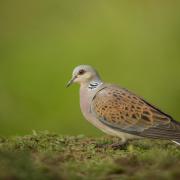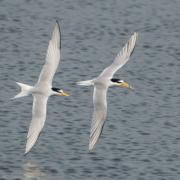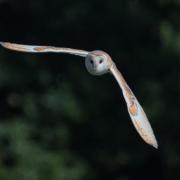RSPB wildlife writer Agnes Rothon marvels at some unusual courtship rituals of our feathered friends

What would you think if your loved one came up to you, looked deep into your eyes then suddenly whipped his or her neck backwards before starting a sequence of head shaking and hair raising?

It might seem a rather bizarre act of love, but this kind of flirtation is what distinguishes the George Clooneys and Cameron Diazs of the water-bird world and makes them attractive to the opposite sex. This particular strange romantic ritual belongs to the great crested grebe, an unmistakable bird with one of the most unusual courtships you will ever encounter.

They’re certainly easy to spot – no great crested grebe would be seen sporting a little black dress, it would be far too dull. Their feathers are stunning and the crown is certainly the pièce de resistance. If you’ve never stopped to look at a grebe close up, I urge you to do so.
Beautiful orange, chestnut and dark red colours adorn their necks. These feathers play a crucial part in any initial flirting and can go a long way to impressing the opposite sex.
Once the grebes have established an initial interest in each other, the entertainment really starts. Both the male and the female start to dance, bobbing up and down and shaking their heads in a performance that could certainly compete with any Strictly Come Dancing stars.
I’m all in favour of romance and certainly wouldn’t turn my nose up at a surprise bunch of flowers. Perhaps a mouthful of weeds might not have the same effect, but if you’re a grebe this sentiment is of the highest calibre. Grebes dive to the bottom of the water to collect a beakful of slimy weed, which they then shake at their partner, the pair floating in the water breast to breast, swaying their necks in unison. This has to be one of the most romantic courtship rituals you will see in the wildlife world.
You don’t have to travel far to spot great crested grebes as your local lake or pit should support a healthy population. Great crested grebes were once near to extinction, especially around the mid 1800s when grebe feathers were used as accessories for ladies’ fashion. This, together with regular robbing of grebe nests, brought the population scarily to low figures. Nowadays, we are able to celebrate the bird’s success and, with laws in place to keep the population healthy, we can appreciate the grebe’s beauty as spectators.
This month’s birdlife
If you are having trouble spotting grebes there are plenty of other things to look out for at this time of year. Woodpeckers and tawny owls begin their courtship displays in winter. Tawny owls will have been making a lot of noise at night time since December and woodpeckers begin drumming in January and February. Remember, the tawny owls distinctive ‘twit twoooo’ call is actually two birds having a conversation. The male starts by calling to the female to advertise his territory to her. If she’s impressed she replies and so completes the familiar call. Woodpeckers advertise their readiness to find a mate by ‘drumming’ with their beaks, often on dead or hollow branches to get maximum resonance.
Winning displays of affection
Every species of wildlife has its own way of winning the heart of the opposite sex. For example, each of the British tit species courts its mate using a different technique. The great tit swells its chest to show off its black stripe, the crested tit, unsurprisingly, raises its crest and the bearded tit puffs out its black cheeks.
Marsh tits start to sing their sneeze-like call in early spring and you might catch a blue tit fluttering from the sky to the ground in a brilliant display of flight, all in the name of love.



























